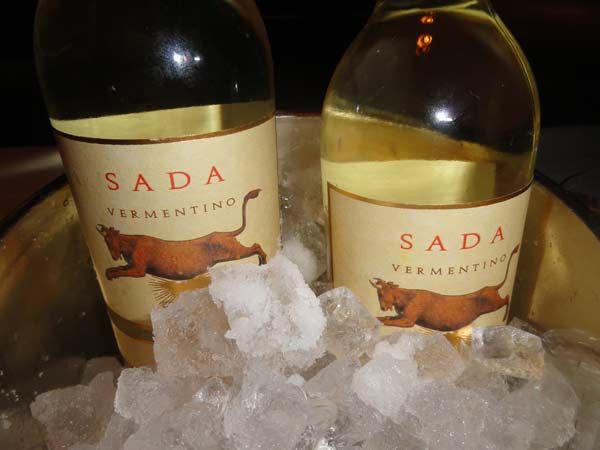The Wines of Davide Sada and Dinner by a Tuscan Chef
(October 15, 2011)
Tuscan Wine and Food the Perfect Combination
Davide Sada is a wine lover and always dreamed of owning his own winery.
Davide however was involved in the family business; his great-great grandfather had patented the technique of vacuum-canning foods and was the creator of what was to become Simmenthal, Italy’s best-known brand of tinned beef.
Sig. Sada at first wanted to start a winery in Friuli, but he changed his mind and his career when he met the well known Italian enologist, Maurizio Castelli, who convinced him to look in the northern part of the Maremma. After a detailed analysis of the land lying between Casale Marittimo, Bibbona and Bolgheri by a geologist friend of Castelli, Davide purchased land that they felt was best suited for growing quality grapes. The new winery was named Azienda Agricola Sada - Fattoria “Carpoli” [4].
Recently, at the Hotel Michaelangelo in NYC Sig. Sada presented his wines at a very special dinner of simply prepared traditional Tuscan food. The dinner was prepared by Emanuele Vallini, chef/owner of La Carabaccia [5]in Bibbona, not far from the winery. Sig. Sada is so proud of the food of this area that he flew Chef Vallini to the US to prepare the food for the dinner.
 |
 |
 |
 |
Vermentino Toscana IGT 2010, 100% Vermentino. The production zone is the Casale Marittimo. The vineyards are at 350 meters. The training system is spurred cordon and the harvest takes place toward the end of September. Vinification is in stainless steel and the wine does not undergo malolatic fermentation. It is aged 5 to 6 months in steel and 2 to 3 months in bottle before release. The wine was fresh and fruity with flavors and aromas of green apple, grapefruit and a touch of honey. It was a perfect combination with the Coccoli della Carabaccia (fried bread dumplings, zucchini flowers vegetables and sage leaves that were passed around as finger food. It also went very well with the first course pappa al pomodoro (bread and ripe tomatoes porridge, flavored with garlic, onions, basil and drizzled with extra-virgin olive oil.) $26
Integolo Toscana IGT 2009 Made from 60% Cabernet Sauvignon, 30-40% Montepulciano. Sig Sada said that if the vintage is lacking and more color is needed in the wine, they will add a small percentage of Alicante, so grape percentages may vary according to the harvest. The production area is Bibbona. The vineyards are at 120 meters, the training system is guyot and the harvest is toward the middle of September. The wine is vinified in stainless steel, aged in steel for 3 months and aged 3 more months in bottle before release. Sig. Sada said that he was trying to make a wine characteristic of the area that was low in price and low in alcohol, what he called “a wine for every day drinking”. It is only 12.5 degrees of alcohol because the leaves of the plants are shaded from the sun. The wine had flavors and aromas of fresh red fruit, with hints of blueberry and good acidity. I think he has succeded. It is an easy drinking wine and went very well with the farro della Garfagnana con pancetta e porro su crema di pepperoni (a timbale of spelt from Garfagnana with bacon and leeks, over a bell pepper cream) $19
Baldoro Toscana IGT 2008 60% Cabernet Sauvignon, 35% Montepulciano and 5% Alicante. Vine training, altitude, harvest and vinification as above. The wine is aged is stainless steel for one year and in bottle for 6 months before release. This wine had fruity red berry flavors and aromas with hints of blackberries and blueberries. This wine had more body than the Integolo and had a longer finish and more lasting aftertaste.
Sig. said that the Baldoro started out as being his “every day” wine but it soon developed into a complex wine with more body and fuller aromas and flavors than the Integolo. He felt that Baldoro would be an excellent wine with steak. We had it with La Carabaccia di Caterina de’Medici (onion soup with fresh egg soup) $26
Carpoli Toscana IGT 2006 65% Cabernet Sauvignon, 30% Cabernet Franc and 5% Petit Verdot. Sig. Sada said that these were the classic grapes of Bolgheri in the Maremma. The altitude, training system, harvest, and vinification are the same as above. The wine is aged in French oak barriques. Less than 1/3 are new and the rest in second and third passage barriques. It spends 8 to 10 months in bottle before release. Sig. Sada said that this was his “Super Tuscan” and a wine to age. It was a little too modern for me but not over the top and was better with the filetto di maiale in crosta di erbette e noci (polk filet in a crust of herbs and walnuts.) $44
Vermentino Toscana IGT 2008 100% Vermentino- Vendemmia Tardiva (late harvest) This wine is not for sale at this time and is only made for family and friends. It was dark brown in color, very dense, thick and sweet. However with the dessert crema di mascarpone con sbrisolona di cantucci (cream of mascarpone with crumbles of cantucci) it was a perfect combination.
At dinner I was sitting next to Sig. Sada and he said that the winery was organic but he does not put it on the label.
TAGS
Azienda Agricola Sada - Fattoria Carpoli [6] La Carabaccia [7] tuscany [8]



